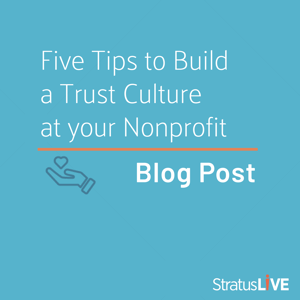One of the top challenges nonprofits face today is displaying data transparency. Not only is your  organization beholden to the government and your board but also your donors. These individuals trust that the dollars contributed to your cause effectively conduct your mission-critical work. Many times, donors even expect proof in terms of quantitative and qualitative data that demonstrate your impact. If your donors expect this level of trust from your organization so does your team. Here are five tips to build a trust culture at your nonprofit:
organization beholden to the government and your board but also your donors. These individuals trust that the dollars contributed to your cause effectively conduct your mission-critical work. Many times, donors even expect proof in terms of quantitative and qualitative data that demonstrate your impact. If your donors expect this level of trust from your organization so does your team. Here are five tips to build a trust culture at your nonprofit:
Utilize one technology system
You might think “how does technology have anything to do with creating a trust culture?” Well, when your team has one system with access to your donor data, email marketing and outcomes information, they have a wholistic view of your organization’s impact. With this information, they feel empowered to perform their roles more efficiently and passionately. They will commit themselves more deeply to your cause.
Compile a shared knowledge base
During our US roadshow stop in Atlanta last fall, one nonprofit professional mentioned she stayed up until 1am the night before combing through multiple Google spreadsheets containing donor information. Many sheets were stored on her colleagues’ personal Google Drive accounts, and each sheet contained contradictory information. As she didn’t trust the information provided, she then created her own spreadsheet with the same information. This task prevented her from creating the email newsletter campaign her team planned to send later that week.
She could have avoided this headache of wrangling multiple spreadsheets if the organization had one single shared knowledge base containing donor profile information. How much time do your team members spend coming through outdated spreadsheets and databases as opposed to doing the work that will propel your organization further?
Leverage automated processes
All fundraisers understand the importance of creating personal relationships with their donors. However, many times, your development staff becomes bogged down in mundane tasks which distract and prevent them from cultivating relationships. As a leader within your organization, look for ways to automate processes such as delivering email campaigns each year on a donor’s birthday or capturing and tracking calls using semi-automated call queues for fundraising campaigns.
Apply Analytical Marketing and Business Intelligence
Once your organization utilizes one technology system and shared knowledge base, the next phase in your digital transformation journey is to apply analytical marketing and business intelligence. Your team will gather and analyze data from the entire organization, make strategic decisions based upon facts not instinct, and improve upon campaigns.
Learn more about Analytical Marketing in our product video:
Focus on people first, then technology
Technology is only as powerful as the people who utilize it. As your organization begins its digital transformation journey, first review your team. Identify their proficiencies and knowledge of your current data. Map out their current tasks and determine any additional duties that technology can automate or amplify. Your staff will appreciate your willingness to increase their efficiencies, allowing them to perform their roles better.
Building a trust culture takes time. However, if you follow these five steps, your team members will feel empowered and inspired to commit themselves more fully to their work. They will appreciate your leadership in acknowledging their worth and your dedication to providing them with the tools necessary to succeed.






